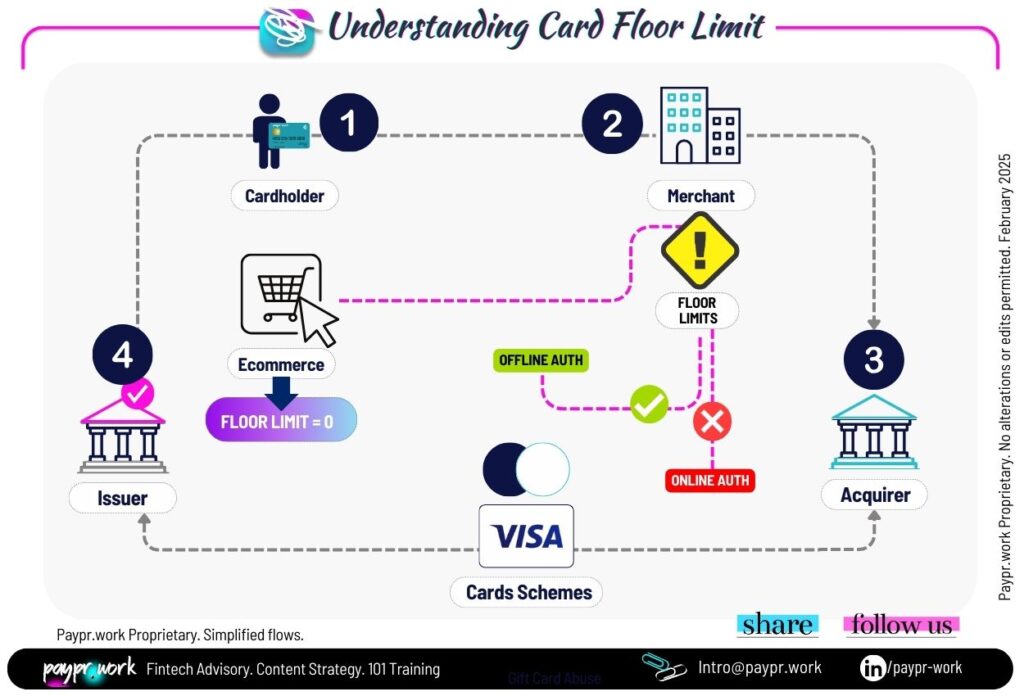
The concept of a card floor limit has played a significant role in the evolution of payment processing. Traditionally, a floor limit represented the maximum transaction amount a merchant could accept without requiring authorization from the card issuer. This practice was essential in offline transactions, helping businesses process small-value payments quickly without needing electronic approval. However, as digital payment systems have become more sophisticated, real-time transaction authorization has largely rendered traditional floor limits obsolete.
In the past, floor limits were determined based on factors such as merchant category, transaction environment, and risk profiles. For example, a retail store might have a higher floor limit than a gas station due to varying fraud risks. These limits were enforced to balance transaction efficiency with fraud prevention, ensuring that small purchases could be processed smoothly while larger transactions required verification.
However, with the widespread adoption of EMV chip technology, contactless payments, and real-time authorization systems, card networks and issuers now approve nearly all transactions instantly. This shift has minimized the relevance of traditional floor limits, as card payments are now validated for security, available funds, and fraud risks in real time.
Despite their diminishing role, floor limits still exist in specific scenarios, such as:
As digital payments continue to surge, the dominance of card networks like Visa and Mastercard highlights the importance of real-time processing. In fiscal year 2024, Visa reported a total payment volume of $15.7 trillion, processing 233.8 billion transactions on its networks. Meanwhile, Mastercard’s net revenues saw a 14% increase, reaching $7.5 billion in the fourth quarter, driven by a 13% rise in payment network revenues and 20% growth in cross-border volumes. These figures underscore how real-time authorization and fraud monitoring have become the backbone of modern payment networks, reducing the necessity of floor limits in most cases.
As payments become increasingly digital and instant, floor limits will continue to fade in importance. However, they may persist in niche use cases where instant authorization is impractical. With the rise of AI-driven fraud detection, biometric authentication, and real-time risk analysis, merchants and consumers alike can enjoy faster, more secure transactions without the constraints of outdated floor limit policies.
In today’s payment ecosystem, real-time authorization has replaced the need for static floor limits, ensuring a seamless and secure experience for businesses and consumers alike.
#didyouknow
◼️From a credit risk perspective, ecommerce transactions are deemed high risk and as a result will pretty much always have a zero-floor limit. This means that all ecommerce transactions are sent for authorisation regardless of the amount.
◼️The floorlimit term dates from back in the days, when cashiers used to authorise payments over the phone, calling the bank literally from the sales floor when a customer passed their limit… hence the term.
◼️ From a credit risk perspective, eCommerce transactions are deemed high risk and, as a result, will pretty much always have a zero-floor limit. This means that all eCommerce transactions are sent for authorization regardless of the amount.
◼️ The floor limit term dates back to the days when cashiers had to authorize payments over the phone, literally calling the bank from the sales floor if a customer exceeded their limit. This process led to the term “floor limit.”
◼️ Some merchants, such as airlines and hotels, may have different floor limits depending on the service. A hotel might set a higher floor limit for room charges, but still require real-time authorization for additional purchases, such as at the minibar or restaurant.
◼️ Floor limits can play a role in disaster recovery scenarios. When payment networks experience outages, some merchants have contingency plans that allow for offline transactions up to a predefined limit before authorization becomes necessary.
◼️ Some countries have regulatory-imposed floor limits for specific transaction types.

Paypr.work blends payment knowledge and custom research into a simplified yet insightful narration. Our narratives feature visually engaging designs that break down both fundamental and complex payment jargons into bite-sized, repetitive micro-concepts to promote better comprehension and retention.
Sign up for a Paypr.work Premium Membership to exclusively access all of our payment resources, including our full articles, industry insights, ecosystem maps, reports, videos, and our unique library of bespoke infographics.
Don’t miss out— sign up to learn payments in a captivating way!



You have provided so much light and knowledge in a fascinating world. You definitely bring the fun to Fintech like no one else and actually know what you are talking about! Thanks goodness for you😁!

Vice President Global Product Expansion, Shift4
Impressive, congratulations Sandra and Team Paypr.work. The detail in each of your 100+ infographics is outstanding and showcases your expertise well… Continued success for this remarkable work!

LinkedIn Strategist | Digital Transformation Leader

Host of Heads Talk
Your diagrams have the ability to explain the most complicated of topics in way that can be understood by anyone. Not many people have the ability to create self-explanatory visuals, so keep doing your magic 🔥🔥🔥!

CEO & Co Founder of CLOWD9
Your content is so informative, accurate, and fabulously presented in infographics that always attract great attention. Your visuals naturally spark strong engagement regardless of the LinkedIn algorithms !

B2B Marketing, Marqeta
The depth of Paypr.work knowledge and skill sets are truly impressive. Their ability to combine deep industry expertise with well-depicted visual is pretty unique. I strongly recommend Sandra and Paypr.work !

Director EMEA Payment Solutions, Marriott International
👏👏 👏👏 👏👏 I always love your content and in fact, I am so happy for all of us in the industry… we’re lucky to have you sharing your payment wisdom with us 🤓… thank you! Keep up the great work.

Strategic Accounts Director, Truelayer | Payments and Fintech Geek
Merci Sandra pour ta facilité à vulgariser le paiement via de simples dessins, qui me surprendront toujours. Pour ceux qui ne connaissent pas son travail, je vous invite à suivre Paypr.work [ˈpeɪpəwəːk]!

Product Manager Paiement, Maisons du Monde
Your enthusiasm and ability to simplify Payments is so refreshing and literally shines through! Sandra and her team research, write content and create some stunning infographics for the payments industry….

Chief Operations Officer, Clowd9
Keep up the good work and know that your hard work and dedication is so inspiring for all of us. You are truly doing an incredible job and your consistent efforts don’t go unnoticed.

Chief Community Officer, NORBr | Redefining Payment Infrastructure | Linkedin Top Voice
Your posts are a masterclass in how payments have evolved from a basic utility to a strategic asset. Your ability to simplify this complexity and provide strategic direction along with implementation support is so invaluable. The clarity and depth you provide are exactly what this fast-evolving industry needs.

Chief Commercial and Operations Officer, Soffid
The mechanics of all things payment are a black box for most industry stakeholders. With the help of their well researched and designed infographics, Sandra and her team at Papr.work demystify complex flows and create awareness about the factors that play a role in the end to end processes.

Paul van Alfen | Managing Director Managing, Up in the Air - Travel Payment Consultancy
Your Paypr.work subscription gets you full access to all Paypr.work content in 1 place including: our weekly new payments articles, our infographic blog, exclusive discounts on all the services that Paypr.work has to offer and the opportunity to collaborate on free infographic to promote your knowledge/value proposition and more. The content is for personal use and cannot be copied, reproduced, redistributed, altered, modified, shared publicly or with third-party nor can derivatives of the work be created. The user may share content that is available through the free blog access subject to crediting Paypr.work with the attributions.